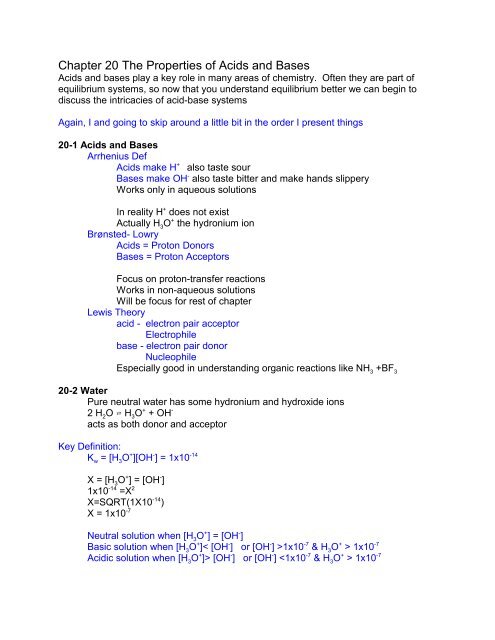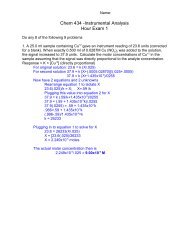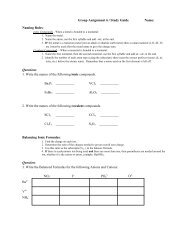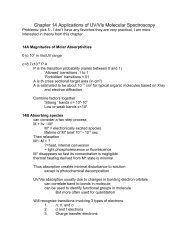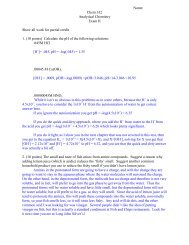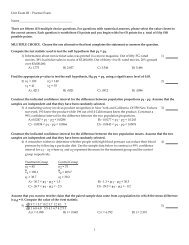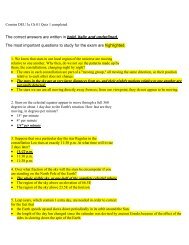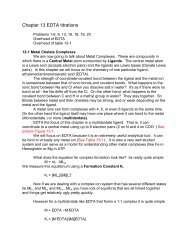Chapter 20 The Properties of Acids and Bases
Chapter 20 The Properties of Acids and Bases
Chapter 20 The Properties of Acids and Bases
Create successful ePaper yourself
Turn your PDF publications into a flip-book with our unique Google optimized e-Paper software.
<strong>Chapter</strong> <strong>20</strong> <strong>The</strong> <strong>Properties</strong> <strong>of</strong> <strong>Acids</strong> <strong>and</strong> <strong>Bases</strong><strong>Acids</strong> <strong>and</strong> bases play a key role in many areas <strong>of</strong> chemistry. Often they are part <strong>of</strong>equilibrium systems, so now that you underst<strong>and</strong> equilibrium better we can begin todiscuss the intricacies <strong>of</strong> acid-base systemsAgain, I <strong>and</strong> going to skip around a little bit in the order I present things<strong>20</strong>-1 <strong>Acids</strong> <strong>and</strong> <strong>Bases</strong>Arrhenius Def<strong>Acids</strong> make H + also taste sour<strong>Bases</strong> make OH - also taste bitter <strong>and</strong> make h<strong>and</strong>s slipperyWorks only in aqueous solutions+In reality H does not exist+Actually H3O the hydronium ionBrønsted- Lowry<strong>Acids</strong> = Proton Donors<strong>Bases</strong> = Proton AcceptorsFocus on proton-transfer reactionsWorks in non-aqueous solutionsWill be focus for rest <strong>of</strong> chapterLewis <strong>The</strong>oryacid - electron pair acceptorElectrophilebase - electron pair donorNucleophileEspecially good in underst<strong>and</strong>ing organic reactions like NH +BF<strong>20</strong>-2 WaterPure neutral water has some hydronium <strong>and</strong> hydroxide ions+ -2 H2O H3O + OHacts as both donor <strong>and</strong> acceptorKey Definition:K = [H O ][OH ] = 1x10w 3+ - -14+ -X = [H3O ] = [OH ]-14 21x10 =X-14X=SQRT(1X10 )3 3X = 1x10 -7 + -Neutral solution when [H3O ] = [OH ]Basic solution when [H3O ]< [OH ] or [OH ] >1x10 & H3O > 1x10Acidic solution when [H O ]> [OH ] or [OH ] 1x10+ - - -7 + -7+ - - -7 + -73 3
2<strong>20</strong>-3 Strong <strong>Acids</strong> <strong>and</strong> <strong>Bases</strong>Key Definition:Strong acids are acids that undergo 100% dissociation in waterStrong bases are bases that undergo 100% dissociation in water<strong>The</strong> common strong acids <strong>and</strong> bases are listed in table <strong>20</strong>.1YOU NEED TO MEMORIZE THESE COMPOUNDSSample calculation+ - -What are the concentrations <strong>of</strong> H3O , Cl <strong>and</strong> OH in .03M HCl100% dissociation so+ -[H3O ]= [Cl ] = .03M-[OH ] comes from K W-14 + -K W = 1x10 = [H3O ][OH ]-14 -1x10 = .03[OH ]- -14 -13[OH ] = 1x10 /.03 = 3.33x10What are the concentrations <strong>of</strong> H O , Ca <strong>and</strong> OH in .03M Ca(OH)100 % dissociation so-[OH ] = .03M Ca(OH) 2 x 2 OH/1Ca(OH) 2 = .06M2+ 2+[Ca ] = .03M Ca(OH) 2 x 1 Ca /1Ca(OH) 2 = .03M+[H3O ] comes from KW-14 + -K W = 1x10 = [H3O ][OH ]-14 +1x10 = .06[H3O ]+ -14 -13[H O ] = 1x10 /.06 = 1.67x103+ 2+ -3 2Neutral IonsNow let’s look at the back reaction- +If HCl + H2O Cl + H3O go to 100% completion-How much <strong>of</strong> a tendency does Cl have to do the back reaction:- -To Cl + H2O HCl + OHZip- Zippo - Zilch-Nada-So Cl is a neutral ionAnd so on for all the anions <strong>of</strong> the strong acidsSimilarly for Na +So the cations <strong>of</strong> strong bases are also neutral<strong>The</strong> neutral ions are summarized in table <strong>20</strong>.3YOU NEED TO MEMORIZE THESE IONS<strong>20</strong>-4 Carboxylic <strong>Acids</strong> Skip temporarily
<strong>20</strong>-5 pH <strong>and</strong> Acidity+ -You will find that the [H ] <strong>and</strong> [OH ] concentrations are are important in many+ -reactions. Even if [H ] <strong>and</strong> [OH ] are not products or reactants in a reaction, they+<strong>of</strong>ten serve as catalysts. In addition, all living organisms carefully try to keep [H ]+ -carefully regulated because small fluctuations in [H ] or [OH ] can easily kill acell+ - -14Generally the concentrations <strong>of</strong> [H ] <strong>and</strong> [OH ] in water range from 1M to 1x10M. With such a broad range <strong>of</strong> concentrations it is convenient to switch to alogarithmic scale. This scale is attributed to Søren Sørenson. <strong>The</strong> p <strong>of</strong> pH isthose to mean the ‘power’ or exponent <strong>of</strong> the hydrogen ion concentrationKey Equation+ +pH = -log[H O ] = -log[H ]3Example problems+Just a page ago we calculated that .03M HCl had a [H ] <strong>of</strong> .03MWhat is the pH <strong>of</strong> this solution?+pH = -log [H ]= -log(.03)= -(-1.52=1.52We also determined that a.03M Ca(OH) 2 had an [H ] <strong>of</strong> 1.67x10What is the pH <strong>of</strong> this solution?+pH = -log [H ]-13= -log(1.67x10 )= -(-12.778)=12.778+ -133You can do the same thing with [OH - ]Key EquationpOH = -log[OH - ]Sample Problem-Continuing with the [OH ] side <strong>of</strong> the previous problems, the .03M Ca(OH) 2 had-an [OH ] .06MpOH = -log(.06)= - (-1.222)
As we tackle the OH side <strong>of</strong> the .03M HCl solution I want to show you somethingIn the original problem we had+[H ] = .03Mthen we used-14 + -K W = 1x10 = [H3O ][OH ]to find that- -14 -13[OH ] = 1x10 /.03 = 3.33x10-13so pOH = -log (3.33x10 ) = -(-12.48) = 12.48Bu there is a shortcutKey EquationpH + pOH = 14(I can derive this for you, but you probably don’t want to sit through the math)Continuing examplewe already said that the pH <strong>of</strong> this solution was 1.52using 14 = 1.52 + pOHpOH = 14-1.52 = 12.48<strong>and</strong> you get exactly the same numberMore on pH scaleEarlier I said that+ -Neutral solution when [H3O ] = [OH ]Basic solution when [H3O ]< [OH ] or [OH ] >1x10 & H3O > 1x10Acidic solution when [H O ]> [OH ] or [OH ] 1x10+ - - -7 + -7+ - - -7 + -73 3Making the equivalent statements using the pH scale we haveNeutral pH = pOH = 7Basic solution is when pH >7 or pOH 1!-log(5) = -.7-.7 !!14 = pH + pOH; pOH = 14.7!4
One last trick problem I may throw at you-8What is the pH <strong>of</strong> 1x10 HCl?Well, that should be easy-8pH = -log(1x10 )= - (-8)=8But what is wrong with that answer? HCl is an acid, but you just got a basic pH!-7 +<strong>The</strong> problem is that you forgot about water. Water is furnishing 1x10 H+ -8 -7so H = 1x10 from the HCl <strong>and</strong> 1x10 from the water for total <strong>of</strong>1.1x10 -7-7pH = -log(1.1x10 ) = 6.96 an acid pHAdding the water contribution on top <strong>of</strong> your original acid or base is only-7necessary when the acid (or base) concentration is < or = 1x10 . It is also a bit<strong>of</strong> a quick <strong>and</strong> dirty approximation, when you get to analytical I will show you theproper way to h<strong>and</strong>le this problem.+pH [H ]By now you know that I want you to be able to do calculations forward <strong>and</strong>+backwards. So how do you calculate [H ] from pH?Example CalculationIf an HNO solution has a pH <strong>of</strong> 4.83, what is the concentration <strong>of</strong> [HNO ]?3 3+pH = -log [H ]+4.53 = -log[H ]+-4.53 = log [H ]How do you get rid <strong>of</strong> the log function? Do 10^ on both sides <strong>of</strong> the equation-4.53On the left side 10^-4.53 = 10On the right side 10^log cancels out so-4.53 +10 = [H ]= 2.95x10 -5Since HNO 3 is a strong acid with 100% ionization+ -5[H ] = [HNO 3] = 2.95x10Summarizing into a single equationKey Equation+ -pH[H ] = 105
6<strong>20</strong>-6 Weak <strong>Acids</strong> <strong>and</strong> <strong>Bases</strong>If strong acids <strong>and</strong> bases have 100% dissociation, what do you think happenswith weak acids <strong>and</strong> bases? You got it,
3. list initial concentrations <strong>and</strong> start your ICE tableHA+ -H + AInitial .006 0 04. Calculate Q to determine what direction(if any) the reaction will shiftWith 0 products we don’t need a Q, you know it will go to products5. using a single variable(X), define change for each concentration needed toreach equilibrium using X.+Here, since we want to calculate pH which comes from [H ] we make+[H ]=X-[A ] = X[HA] = -X6. Substitute modified concentration terms into the ICE table <strong>and</strong> the equilibriumexpressionHA+ -H + AInitial .006 0 0Change -X X XEq .006-X X XK a = XX/(.006-X)-5K a = 1.8x10 (from table <strong>20</strong>.4)-51.8x10 = XX/(.006-X)7. Solve the equilibrium expression for the unknown<strong>The</strong>re are two ways to solve this, long <strong>and</strong> shortStart with the long-5 2(.006-X)1.8x10 =X-7 -5 21.08x10 -1.8x10 X = X2 -5 -7X + 1.8x10 X -1.08x10 =02Using the quadratic -b +/- sqrt(b -4AC) / 2A-5 -10 -7-1.8x10 +/- sqrt(3.24x10 + 4.32x10 ) / 2-5 -7-1.8x10 +/- sqrt(4.323x10 ) / 2-5 -4-1.8x10 +/- 6.575x10 /2Ignoring the - root-4 -5(6.575x10 -1.8x10 )/2-46.395x10 /23.18x10 -4-4pH = -log(3.18x10 ) = 3.49Now the short, quick <strong>and</strong> dirtyIf X si small, the reaction does not go far to the right so.006-X ~ .006-5 21.8x10 ~ X /.006-5 -4X = sqrt(.0061.8x10 ) = 3.29x10 ; pH = 3.488
9A little <strong>of</strong>f, but not too bad-4<strong>The</strong> quick <strong>and</strong> dirty method usually works if the K a is 10 or less-3if you see a K <strong>of</strong> 10 or greater you should use the quadratica<strong>20</strong>-8 Successive Approximation<strong>The</strong> Q&D answer we got above was a lot faster than the quadratic, but us was<strong>of</strong>f a bit-4 -4 -43.28x10 - 3.18x10 = .10x10-4 -4.10x10 /3.18x10 x 100% = ~3% error<strong>The</strong> method <strong>of</strong> successive approximation is a way to get closer to the realanswer without the quadraticIn the Q&D we did an approximation that .006-X ~ .006But once we solved the equation <strong>and</strong> found that X = 3.28x10 -4we can improve our answer-4Out improved answer is that .006-3.28x10 =.005672And not solve the problem with is better approximation-5 21.8x10 ~ X /.005672-5 -4X = sqrt(.0056721.8x10 ) = 3.29x10 ; pH = 3.48X = 3.19x10 -4And now our answer is < 1% <strong>of</strong>f.You can even set up a spread sheet to do this over <strong>and</strong> over. But most <strong>of</strong> thetime a single iteration will be just fine for most weak acid problemsNow that you know how to h<strong>and</strong>le weak acids, <strong>and</strong> you have seen the table withlots <strong>of</strong> different weak acids it is time to look at the most common weak acid seen inorganic chemistry the carboxylic acid<strong>20</strong>-4 <strong>The</strong> carboxylic acid (out <strong>of</strong> order)<strong>The</strong> most common acid you see in organic chemistry is the carboxylic acid <strong>of</strong>tenrepresented with the atoms COOH<strong>The</strong> structure is shown above, where R represents H or any C containing group
Two <strong>of</strong> the acids you may be familiar with are acetic acid <strong>and</strong> formic acid. Aceticacid is the acid (<strong>and</strong> the smell) found in vinegar, Formic acid is the irritant foundin <strong>and</strong> bites ( it was first isolated in 1600's by distilling ants!)10<strong>The</strong> acidic proton on these structures is the H on the COOH group.If you think about it you might wonder why. After all H-O-H with OH bonds is notacidic, <strong>and</strong> alcohols C-O-H groups are not acidic either. Th answer lies is thefact that the anion that is formed when the proton leaves is stabilized byspreading out the negative charge over 2 atoms as shown below:Is is interesting that you can actually see this in x-ray structures. <strong>The</strong> C=O bondis 123 pm, the C-O-H bond is 136 pm <strong>and</strong> the C-O bond in then resonance stablizedanion is 127 pm<strong>20</strong>-9 K B <strong>and</strong> base strengthNow let’s turn our attention to weak bases<strong>The</strong> generic base reaction is:B + H O BH + OH -2-So in this case the OH that you associate with something being basic is theproduct <strong>of</strong> the reaction <strong>of</strong> a base with waterNotice in the reaction B the base was a proton acceptor which matches ourBronstead Lowry defintion
11Or H HH-N: + H-O-H H-N-H + OH -H H<strong>The</strong> pair <strong>of</strong> electrons are donated to water which agrees with the Lewis model <strong>of</strong>a baseAgain this is a equilibrium reaction with a K, but we usually use the symbol K B forthe base ionization or base protonation constant. In a similar manner as theacidsKey Concept<strong>The</strong> larger the K B, the more the reaction goes to the right, so the stronger thebaseTable <strong>20</strong>.5Key EquationpK ‘s for -log(K )BBClicker questionRank the bases ammonia, aniline, <strong>and</strong> ethylamine from weakest to strongestbaseAll <strong>of</strong> the weak bases found in this table are amines, or nitrogen containingorganic molecules. <strong>The</strong> lone pair <strong>of</strong> electrons on the nitrogen that can eitheraccept protons or donate electrons (depends on the definition <strong>of</strong> base you use)is what these bases all have in common+Calculating the [H ] or pH due to a base follows the same kind <strong>of</strong> logic ascalculation involving acids, you just have to add one more stepSample CalculationLet’s calculate the pH <strong>of</strong> a .04M ethylamineAgain we attack this problem just like any other equilibrium problem1. Write the balanced reaction CH3CH2NH 2 + H2O CH3CH2NH 3 + OH -+ -I will shortcut this to B + H2O BH + OH2. Write the equilibrium expression that corresponds to the balanced reaction+ -K B =[BH ][OH ]/[B]3. list initial concentrations <strong>and</strong> start your ICE table+ -B H2O BH + OHInitial .04 Constant 0 04. Calculate Q to determine what direction(if any) the reaction will shiftWith 0 products we don’t need a Q, you know it will go to products5. using a single variable(X), define change for each concentration needed to
each equilibrium using X.Here, since we want to calculate pH which can be calculated form pOH- -which comes from [OH ] we make [OH ]=X- +[OH ] = X = [BH ][B] = -X6. Substitute modified concentration terms into the ICE table <strong>and</strong> the equilibriumexpression+ -B H2O BH + OHInitial .04 Const 0 0Change -X X XEq .04-X X XK B = XX/(.04-X)-4K B = 4.5x10 (from table <strong>20</strong>.5)-44.5x10 = XX/(.04-X)7. Solve the equilibrium expression for the unknown<strong>The</strong>re are three ways to solve this, long <strong>and</strong> short, <strong>and</strong> successive approximationLet’s just do the successive approximationst1 approximation.04-X ~ X-4 24.5x10 =X /.04-4X = sqrt (4.5x10 .04)x ~ .00424ND2 approximation.04 -X ~.04 - .00424 ~ .03576-4 24.5x10 =X /.03576-4X = sqrt (4.5x10 .03576)x ~ .0040-But X = [OH ] <strong>and</strong> we want pH, so-[OH ] =.004, pOH = -log(.004)= 2.40pH = 14-2.40 = 11.60<strong>20</strong>-10 Conjugate Acid-Base PairsSo far we have concentrated on the forward reaction HA + H2O A + H3O+ -Or B + H O BH + OH2But now let’s look at the reverse reactions- + + -A + H O HA + H O Or BH + OH B + H O3 2 2Note that re reverse reactions are also acid base reactions- + + -A + H3O HA + H2O Or BH + OH B + H2OH Acceptor H Donor H donor H acceptorAcid Base Acid Base- +12
Key DefinitionSo the acid’s anion is a base in the reverse reaction - we call this a conjugatebase <strong>and</strong> a base’s cation is an acid in the reverse reaction - we call this aconjugate acidSample problemsWhat are the conjugates bases <strong>of</strong> the following acids?- +HClO 3, H2PO 4 , <strong>and</strong> CH3NH3<strong>Acids</strong> are proton donators, so what ion do you have left after they have donated- 2-their proton - ClO , HPO <strong>and</strong> CH NH3 4 3 2What are the conjugate acids <strong>of</strong> the following bases?-2 -CH NHCH , HPO , F3 3 4<strong>Bases</strong> are proton acceptors so what do you have after you have accepted a+ -proton? - CH NH CH , H PO , HF3 2 3 2 4So the conjugate form <strong>of</strong> the weak acids are bases, <strong>and</strong> will make the solutionbasic. Also the conjugate form <strong>of</strong> the weak bases are acids, <strong>and</strong> will make thesolution acidic. Now a reminder. What is the conjugate form <strong>of</strong> HCl, <strong>and</strong> is it anacids or a base. Similarly, what is the conjugate form <strong>of</strong> NaOH, <strong>and</strong> will it makea solution acid or base? (<strong>The</strong> anions <strong>of</strong> strong acids are neutral, the cations <strong>of</strong>strong bases are neutral !)K b’s <strong>of</strong> weak acids-So now you know that the acetate anion, CH3COO should be basic because it isa conjugate base. But how strong a base is it?Well considerCH COOH + H O CH COO + H O , K = 1.75x10- + -53 2 3 3 aFor the reverse reaction- +CH COO + H O CH COOH + H O Reverse so K = 1/K3 3 3 2 aH O + H O H O + OH+ -2 2 3 wKNow if we add the above two equations together, what do we do with the K’s?(Multiply them)<strong>The</strong> result is- -CH3COO + H2O CH3COOH + OH <strong>and</strong> this is our base reaction for the acetateion.13
14-14 -5 -10K B = K w/K A = 1x10 /1.75x10 = 5.71x10Key Equation<strong>The</strong> K b for the conjugate base <strong>of</strong> a weak acid = K w/KASimilarly for bases<strong>The</strong> K for the conjugate acid <strong>of</strong> a weak base = K /KOr, more simply, K K =KA W BA B WSample calculation+What is the K for ammonia (NH )A 4-5K B for ammonia = 1.8x10 (table <strong>20</strong>.5)K = K /K = 5.7x10 -10A w B<strong>20</strong>-11 Salt solutionsWe started this chapter looking at strong acids <strong>and</strong> bases, then we worked onweak acids <strong>and</strong> bases, <strong>and</strong> just now we did the conjugate forms <strong>of</strong> the acids <strong>and</strong>bases. Now let’s put all these different pieces together into a compound called asalt.Back in chapter 10 you learned that a salt is the product <strong>of</strong> an acid baseneutralization reaction, so let’s start there.What do you get when you neutralize an acid like HCl with NaOH?HCl + NaOH NaCl(aq) + H2O+ -Early on in this chapter you learned that Na <strong>and</strong> Cl were neutral ions, so the pH<strong>of</strong> the neutralized solution is indeed, neutral.Now what about CH3COOH <strong>and</strong> NaOH?CH COOH + NaOH CH COONa(aq) + H O3 3 2But as an ionic compound CH COONa Na + CH COO+ -Na neutral CH COO basic (C.B <strong>of</strong> a weak acid)3+ -3 3+ -How about HCl <strong>and</strong> NH 3 NH 4 (acidic) <strong>and</strong> Cl (neutral)So neutralization reactions can leave you neutral, or acidic or basic!What is a person to do? On top <strong>of</strong> that, sometimes I won’t even give you theneutralization reaction, I will just give you the salt, say NaHSO 3. Are you up theproverbial creek without a paddle?Key Procedure:1. Break each salts into its component anion <strong>and</strong> cation2. Ignore the neutral cations <strong>and</strong> anions3. Identify the acid/base properties <strong>of</strong> the remaining cation or anion
Table <strong>20</strong>.7 is a nice table that summarizes the acid/base properties <strong>of</strong> many ionsbut you shouldn’t have to memorize this table, you should be able to use logicrememberthe cations <strong>of</strong> strong bases are neutral, so this means basically the firsttwo column <strong>of</strong> the periodic table<strong>The</strong> anions <strong>of</strong> strong acids are neutral, <strong>and</strong> you shoul dknow your straongacids by nowSo you can ignore all <strong>of</strong> the aboveLooking at what remains<strong>The</strong> basic anions are the conjugate bases <strong>of</strong> weak acids<strong>The</strong> acidic cations are the conjugate acids <strong>of</strong> weak bases (<strong>and</strong> Ithink all have a N in them!)Table <strong>20</strong>.7 does have a few that don’t fit above. Let’s examine them moreclosely1. <strong>The</strong>re are no basic cations!2. Cations with >+2 charge tend to be acidicLast semester we talked about waters <strong>of</strong> hydration, that is watersthat are bound to + cationsWhen you have a highly charge cation, the cation actually grabs- +the water so strongly that it splits the water into OH <strong>and</strong> H . <strong>The</strong>- +OH stays attached to the metal <strong>and</strong> the H is releasedExample:3+ 3+ 2+ +Al (aq) is actually [Al(H O) ] (aq) [Al(OH)(H O) ] (aq) + H (aq)2 6 2 515Added material NOT in your textAcid-Base properties <strong>of</strong> Oxides<strong>The</strong>re is another class <strong>of</strong> compounds that have acid/base properties that we canidentify fairly easily <strong>and</strong> that is the oxides.In nature you will find oxides <strong>of</strong> virtually every element. Oxides can be eitheracidic or basic. You now have enough chemistry behind you that you can beginto underst<strong>and</strong> these properties <strong>and</strong> to predict them <strong>of</strong> unknown compounds.Let’s start with the acidic oxides. When a covalent oxide dissolves in water is willform an acidic solution. Examples:SO 3 (g) + H2O(l) H2SO 4(aq)SO 2 (g) + H2O(l) H2SO 3(aq)CO 2 (g) + H2O(l) H2CO 3(aq)2NO (g) + H O(l) HNO (aq) + HNO (aq)2 2 3 2
16On the other h<strong>and</strong> when ionic oxides dissolve in water we get basic solutionsCaO(s) + H2O(l) Ca(OH) 2(aq)Na2O(s) + H2O(l) 2NaOH(aq)K2O(s) + H2O(l) 2KOH(aq)<strong>and</strong> these are called basic oxidesIn our covalent oxides the oxygen has a covalent bond to the cental atom <strong>and</strong>the H, <strong>and</strong> the bond between the central atom <strong>and</strong> the O is stronger than thebond between the O <strong>and</strong> the H so the H may be easily removedIn the ionic compound there is no covalent bond between the metal <strong>and</strong> the O 2-anion. <strong>The</strong> oxide anion, in fact, has a high affinity for protons (a strong base)<strong>and</strong> will pull the <strong>of</strong>f <strong>of</strong> water2- -O (aq) + H2O(l) 2OH (aq)Making most ionic oxides basicBut hold it... In the lab you should have found that CrO 3, a metal oxide had a pH+6<strong>of</strong> 2 or less. What gives? (In this compound you have Cr We just talked abouthow metal ions with strong + Charge can be acids, here the acidity <strong>of</strong> the +6metal ion has overpowered the basicity <strong>of</strong> the metal-oxide)Practice problems Maybe Clicker questionsIdentify the following compounds as acids or basesNaCl (N)CH3COOK (B)RbF (B)NH4NO 3 (A)CaO (B)SO 2 (A)CH COONH (Trick question - N)3 4<strong>20</strong>-12 Polyprotic <strong>Acids</strong>Let’s talk a bit about H2SO 4 <strong>and</strong> H3PO4<strong>The</strong>se are examples <strong>of</strong> polyproitic acids, acid that have more than one proton togive. <strong>The</strong>re ae several polyprotic acids listed in table <strong>20</strong>.9 <strong>of</strong> your text.If you look at the K’s <strong>of</strong> the polyprotics, you will see that form most <strong>of</strong> them thefirst K is relatively strong, but the second is much weaker. Can you figure outwhy?


